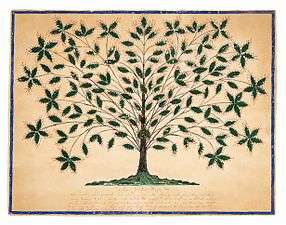Early chronology of Shakers
 |
| Topics |
|---|
|
| Notable people |
|
The Early chronology of Shakers is a list of important events beginning in 1774 when the Shakers emigrated from England the colonial America.
Chronology
In 1774, Shakers emigrated from England to America and settled in New York.[1]
In 1778, the first new members were recorded as joining the community.
In 1779, New Light Baptists held a spiritualistic revival in New Lebanon. They held daily meetings that included extraordinary spiritual phenomena, speaking in tongues, and visions.[2] Their religious fervor died down over the winter, but when they heard of Ann Lee's preaching in May 1780, many of those New Lights traveled to Niskayuna, some forty miles away, to meet her.
In 1780, soon after the "Dark Day," Ann Lee opened her gospel to the public. Soon thereafter, she and several of her followers were arrested as British spies or sympathizers and jailed. The Shakers were, in fact, pacifists during and after the American War of Independence.[3]
From 1781 to 1783, Ann Lee and some of her followers traveled on an extended missionary tour of New England, gathering converts and establishing a network of followers. In several localities, mobs attacked them, and the Shakers were whipped, beaten, and assaulted.[4]
In 1784, Ann Lee died at Watervliet, New York, perhaps due to the after-effects of the assaults during her missionary tour. One of the first Elders, James Whittaker, took over leadership of the society.
In 1787, James Whittaker died and Joseph Meacham became the first Elder.[5] Meacham began "gathering into order," bringing scattered Believers together and organizing them into communal families.[6] The first community is organized by Meacham at Mount Lebanon, called New Lebanon until 1861.
In 1788, Joseph Meacham brought Lucy Wright into the New Lebanon Ministry to serve with him. Together they gathered Shakers "into order" in their own communities, established the administrative structure that would promote equality of the sexes, and began building the villages that would become the Shakers' most visible sign of success.
In 1790, Shaker enclaves were organized at Hancock, Massachusetts, and Enfield, Connecticut; in 1792, Canterbury, New Hampshire and Tyringham, Massachusetts followed suit; 1793, Alfred, Maine, Enfield, New Hampshire, Harvard and Shirley, Massachusetts; 1794, New Gloucester (Sabbathday Lake), Maine.[6]
In 1796, Joseph Meacham died. Lucy Wright remained at the head of the Ministry until her death in 1821.
By 1800, the Watervliet community totaled 87 members.
From 1802 to 1805, Lucy Wright sent Shaker missionaries to proselytize in Vermont, New York, Ohio, and Kentucky. As a result, Shakers established several new colonies (see below).
In 1810, the West Union community was organized at Busro, Indiana (but was abandoned in 1827).[7] In 1821, soon after Lucy Wright died, the Shakers codified their rules for the first time as the Millennial Laws of 1821.[8] In 1826, another Shaker group was organized at Groveland Shaker Village, Groveland, New York.[9] The Sodus Bay Shaker Tract was established in 1833 and existed until 1844.[10] In 1837, the Shaker Era of Manifestations began at Watervliet, New York (see below).
After 1850 the Shakers lost their momentum and added only occasional new members - sometimes orphans left in their care.[11] In 1871, they started publishing a monthly magazine called The Shaker (later, Shaker and Shakeress, and Shaker Manifesto.)[12] In 1888, the Shakers amended their Millennial Laws for the fourth time; this version remains in effect.[13]
From 1889 to 1932, dwindling membership led to the closing of eleven Shaker villages and consolidation of members at the remaining sites.[14] In 1905, the Mount Lebanon Shakers hosted a Peace Convention.[15] In 1947, the last seven remaining Mount Lebanon Shakers left the North Family and moved into nearby Hancock Shaker Village and retirement homes.
Currently, there are three active Shakers living and working at Sabbathday Lake Shaker Village in New Gloucester, Maine.
References
- ↑ Edward D. Andrews, The People Called Shakers (1963), p. 13.
- ↑ J.E.A. Smith, History of Pittsfield, vol. 1 (Boston: Lee and Shepard, 1869), 453.
- ↑ Stein, The Shaker Experience in America pp. 13–14.
- ↑ There's a map of the tour in Stein, Shaker Experience in America, pp. 20–21.
- ↑ Andrews, People Called Shakers, chapter 3.
- 1 2 Andrews, People Called Shakers, p. 290.
- ↑ Andrews, People Called Shakers, p. 290-91.
- ↑ Theodore E. Johnson, ed., “The Millennial Laws of 1821,” Shaker Quarterly 7.2 (1967): 35–58.
- ↑ Andrews, People Called Shakers, p. 291.
- ↑ Nancy L. Todd (July 2009). "National Register of Historic Places Registration: Alasa Farms". New York State Office of Parks, Recreation and Historic Preservation. Retrieved 2011-10-05.See also: "Accompanying 20 photos".
- ↑ Stein, The Shaker Experience in America p. 198.
- ↑ The Shakers' monthly magazine, 1871–1899, also known as The Shaker Manifesto is available online through Hamilton College Library Digital Collections.
- ↑ Stephen J. Paterwic, Historical Dictionary of the Shakers (Lanham, Md.: Scarecrow Press, 2008).
- ↑ Andrews, People Called Shakers, pp. 290–91.
- ↑ Stein, Shaker Experience in America, pp. 316–17.